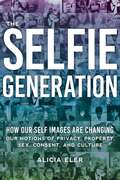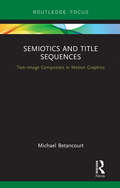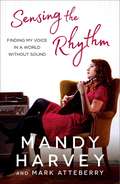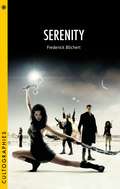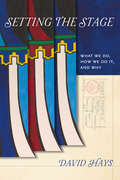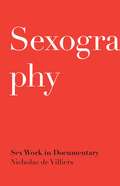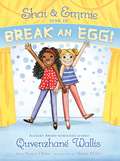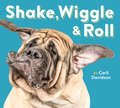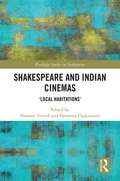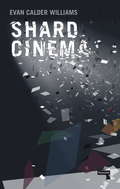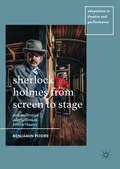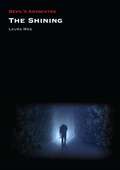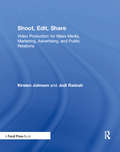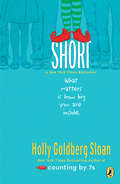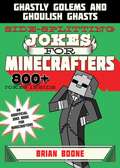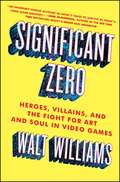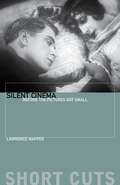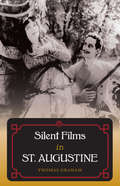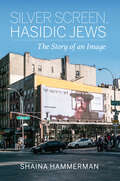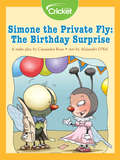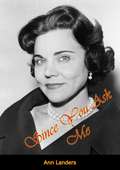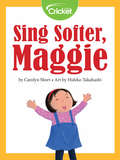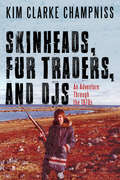- Table View
- List View
See Ya Later: The World According to Arron Crascall
by Arron CrascallAlright guys? It's me, Arron. Or as some people call me, 'that guy with the phone, the skinny jeans and the really fat head'.In a world that seems to be freefalling without a parachute towards utter chaos, I'm here to remind you that when life gives you lemons, make lemonade. No, in fact, when life gives you lemons, make a fool out of yourself in the lemonade aisle.*Because there's more to life than Brexit, Bake Off and banging on about being vegan. Yes, with this book - which is my take on the world - you will learn how to survive a proper lads' holiday, become a master in the art of takeaway ordering and find out about the pitfalls of seriously inappropriate tattoos.So do yourself a favour: turn off the news, cancel that juice cleanse, open your eyes to the brilliant, hilarious world we live in and most importantly . . . buy this book.SEE YA LATER! Arron x*Actually, don't do exactly that, that's my thing.Written and Read by Arron Crascall(p) Orion Publishing Group 2017
The Selfie Generation: How Our Self-Images Are Changing Our Notions of Privacy, Sex, Consent, and Culture
by Alicia Eler<p>Whether it's Kim Kardashian uploading picture after picture to Instagram or your roommate posting a mid-vacation shot to Facebook, selfies receive mixed reactions. But are selfies more than, as many critics lament, a symptom of a self-absorbed generation? <p>Millennial Alicia Eler's The Selfie Generation is the first book to delve fully into this ubiquitous and much-maligned part of social media, including why people take them in the first place and the ways they can change how we see ourselves. Eler argues that selfies are just one facet of how we can use digital media to create a personal brand in the modern age. More than just a picture, they are an important part of how we live today. <p>Eler examines all aspects of selfies, online social networks, and the generation that has grown up with them. She looks at how the boundaries between people’s physical and digital lives have blurred with social media; she explores questions of privacy, consent, ownership, and authenticity; and she points out important issues of sexism and double standards wherein women are encouraged to take them but then become subject to criticism and judgment. Alicia discusses the selfie as a paradox—both an image with potential for self-empowerment, yet also a symbol of complacency within surveillance culture The Selfie Generation explores just how much social media has changed the ways that people connect, communicate, and present themselves to the world.</p>
Semiotics and Title Sequences: Text-Image Composites in Motion Graphics (Routledge Studies in Media Theory and Practice)
by Michael BetancourtTitle sequences are the most obvious place where photography and typography combine on-screen, yet they are also a commonly neglected part of film studies. Semiotics and Title Sequences presents the first theoretical model and historical consideration of how text and image combine to create meaning in title sequences for film and television, before extending its analysis to include subtitles, intertitles, and the narrative role for typography. Detailed close readings of classic films starting with The Cabinet of Dr. Caligari, and including To Kill A Mockingbird, Dr. Strangelove, and The Good, the Bad and the Ugly, along with designs from television programs such as Magnum P.I., Castle, and Vikings present a critical assessment of title sequences as both an independent art form and an introduction to the film that follows.
Sensing the Rhythm: Finding My Voice in a World Without Sound
by Mark Atteberry Mandy HarveyThe inspiring true story of Mandy Harvey—a young woman who became deaf at age nineteen while pursuing a degree in music—and how she overcame adversity and found the courage to live out her dreams.When Mandy Harvey began her freshman year at Colorado State University, she could see her future coming together right before her eyes. A gifted musician with perfect pitch, she planned to get a music degree and pursue a career doing what she loved. But less than two months into her first semester, she noticed she was having trouble hearing her professors. In a matter of months, Mandy was profoundly deaf. With her dreams so completely crushed, Mandy dropped out of college and suffered a year of severe depression. But one day, things changed. Mandy’s father asked her to join him in their once favorite pastime—recording music together—and the result was stunningly beautiful. Mandy soon learned to sense the vibrations of the music through her bare feet on a stage floor and to watch visual cues from her live accompaniment. The result was that she now sings on key, on beat, and in time, performing jazz, ballads, and sultry blues around the country. Full of inspiring wisdom and honest advice, Sensing the Rhythm is a deeply moving story about Mandy’s journey through profound loss, how she found hope and meaning in the face of adversity, and how she discovered a new sense of passion and joy.
Serenity: Essays On Serenity (Cultographies)
by Frederick BlichertJoss Whedon’s Serenity (2005) is at once a symbol of failure and a triumphant success of fan activism. The cult television icon's feature directorial debut functions as an extension of his canceled Fox series Firefly. Mourning their loss, fans of the show fought for more, making Serenity not just a cult film but a monument to cultdom. A minor box-office success upon first release, Serenity continues to be a sci-fi favorite, attracting fans, cosplayers, fan fiction authors, and more to conventions and charity screenings internationally.This book examines the relationship between the film and its peculiar cult following, largely established before a cult object even existed, and situates the film in relation to the series and its other transmedia continuations to plumb the status of different media texts and their platforms. Additionally, it explores those cult features of Serenity—a playful engagement with genre, with high and low culture, with gender roles—that predisposed it to such a fierce following, one that would follow Whedon into future series and blockbuster projects such as The Avengers.
Setting the Stage: What We Do, How We Do It, and Why
by David HaysDavid Hays, elected to the Theater Hall of Fame in 2014, created an exciting and successful career designing scenery and lighting for plays and musicals on Broadway, in London, and in Japan. Told with passion and wit, this book takes readers behind the scenes of the theater world to show how a stage designer collaborates with directors and producers to create great works of theater and dance. A designer who collaborated with the great directors of his time—Arthur Penn, Garson Kanin, Tyrone Guthrie, Elia Kazan, Jose Quintero, and Joe Layton—shares anecdotes that integrate technical insight with life lessons. He designed sets for the Metropolitan Opera, for Lincoln Center, for Martha Graham, and thirty ballets for George Balanchine. This colorful account of theater life is for scholars, practioners, and theatregoers interested in how it all works.Publication of this book is funded by the Beatrice Fox Auerbach Foundation Fund at the Hartford Foundation for Public Giving.
Sexography: Sex Work in Documentary
by Nicholas De VilliersThe turn of the twenty-first century has witnessed an eruption of nonfiction films on sex work. The first book to examine a cross-section of this diverse and transnational body of work, Sexography confronts the ethical questions raised by ethnographic documentary and interviews with sexually marginalized subjects. Nicholas de Villiers argues that carnal and cultural knowledge are inextricably entangled in ethnographic sex work documentaries.De Villiers offers a reading of cinema as a technology of truth and advances a theory of confessional and counterconfessional performance by the interviewed subject who must negotiate both loaded questions and stigma. He pays special attention to the tactical negotiation of power in these films and how cultural and geopolitical shifts have affected sex work and sex workers. Throughout, Sexography analyzes the films of a range of non–sex-worker filmmakers, including Jennie Livingston, Pier Paolo Pasolini, Shohini Ghosh, and Cui Zi’en, as well as films produced by sex workers. In addition, it identifies important parallels and intersections between queer and sex worker rights activist movements and their documentary historiography.De Villiers ultimately demonstrates how commercial sex is intertwined with culture and power. He advocates shifting our approach from scrutinizing the motives of those who sell sex to examining the motives and roles of the filmmakers and transnational audiences creating and consuming films about sex work.
Shai & Emmie Star in Break an Egg! (A Shai & Emmie Story #1)
by Sharee Miller Nancy Ohlin Quvenzhané WallisFrom Academy Award–nominated actress Quvenzhané Wallis comes the first story in a brand-new series about best friends Shai and Emmie, two third graders destined for superstardom.Shai Williams was born to be a star (or a veterinarian—and maybe a dentist). She attends a special elementary school for the performing arts, and her grandma Rosa and aunt Mac-N-Cheese are both actresses. So Shai is shocked when she doesn’t get the lead role in the third-grade musical. Instead, the part goes to the new girl, Gabby Supreme, who thinks she is better than everyone else. To add insult to injury, Ms. Gremillion has now asked Shai to help Gabby with the role. Shai reluctantly agrees and enlists Emmie to help, but Gabby isn’t going to make it easy. As opening night draws near, Shai discovers that making a new friend is sometimes like putting on a show—it requires dedication, patience, and lots and lots of practice.
Shake, Wiggle & Roll
by Carli DavidsonIn Shake, Wiggle & Roll, babies and toddlers will be moving and grooving with playful pups as they show off favorite doggie moves, from chomping and chewing to jumping and leaping. With lively images from the lens of expert animal photographer Carli Davidson, this sturdy book is perfect for the very youngest readers—and fun for the whole family.
Shakespeare and Indian Cinemas: "Local Habitations" (Routledge Studies in Shakespeare)
by Poonam Trivedi Paromita ChakravartiThis book is the first to explore the rich archive of Shakespeare in Indian cinemas, including less familiar, Indian language cinemas to contribute to the assessment of the expanding repertoire of Shakespeare films worldwide. Essays cover mainstream and regional Indian cinemas such as the better known Tamil and Kannada, as well as the less familiar regions of the North Eastern states. The volume visits diverse filmic genres, starting from the earliest silent cinema, to diasporic films made for global audiences, television films, independent films, and documentaries, thus expanding the very notion of ‘Indian cinema’ while also looking at the different modalities of deploying Shakespeare specific to these genres. Shakespeareans and film scholars provide an alternative history of the development of Indian cinemas through its negotiations with Shakespeare focusing on the inter-textualities between Shakespearean theatre, regional cinema, performative traditions, and literary histories in India. The purpose is not to catalog examples of Shakespearean influence but to analyze the interplay of the aesthetic, historical, socio-political, and theoretical contexts in which Indian language films have turned to Shakespeare and to what purpose. The discussion extends from the content of the plays to the modes of their cinematic and intermedial translations. It thus tracks the intra–Indian flows and cross-currents between the various film industries, and intervenes in the politics of multiculturalism and inter/intraculturalism built up around Shakespearean appropriations. Contributing to current studies in global Shakespeare, this book marks a discursive shift in the way Shakespeare on screen is predominantly theorized, as well as how Indian cinema, particularly ‘Shakespeare in Indian cinema’ is understood.
Shard Cinema
by Evan Calder WilliamsShard Cinema tells an expansive story of how moving images have changed in the last three decades and how they changed us along with them, rewiring the ways we watch, fight, and navigate an unsteady world. With a range that spans film, games, software, architecture, and military technologies, the book crosses the twentieth century into our present to confront a new order of seeing and making that took slow shape: the composite image, where no clean distinction can be made between production and post-production, filmed and animated, material and digital. Giving equal ground to costly blockbusters and shaky riot footage, Williams leads us from computer-generated “shards” of particles and debris to the broken phone screen on which we watch those digital storms, looking for the unexpected histories lived in the interval between.
Sherlock Holmes from Screen to Stage
by Benjamin PooreThis book investigates the development of Sherlock Holmes adaptations in British theatre since the turn of the millennium. Sherlock Holmes has become a cultural phenomenon all over again in the twenty-first century, as a result of the television series Sherlock and Elementary, and films like Mr Holmes and the Guy Ritchie franchise starring Robert Downey Jr. In the light of these new interpretations, British theatre has produced timely and topical responses to developments in the screen Sherlocks' stories. Moreover, stage Sherlocks of the last three decades have often anticipated the knowing, metafictional tropes employed by screen adaptations. This study traces the recent history of Sherlock Holmes in the theatre, about which very little has been written for an academic readership. It argues that the world of Sherlock Holmes is conveyed in theatre by a variety of games that activate new modes of audience engagement.
The Shining (Devil's Advocates)
by Laura MeeTaking a fresh look at The Shining (1980), this book situates the film within the history of the horror genre and examines its rightful status as one of the greatest horror movies ever made. It explores how Stanley Kubrick's filmmaking style, use of dark humor, and ambiguous approach to supernatural storytelling complements generic conventions, and it analyzes the effective choices made in adapting King's book for the screen—stripping the novel's backstory, rejecting its clear explanations of the Overlook Hotel's hauntings, and emphasizing the strained relationships of the Torrance family. The fractured family unit and patriarchal terror of Kubrick's film, alongside its allusions to issues of gender, race, and class, connect it to themes prevalent in horror cinema by the end of the 1970s, and are shown to offer a critique of American society that chimed with the era's political climate as well as its genre trends. The film's impact on horror cinema and broader pop culture is ever apparent, with homages in everything from Toy Story to American Horror Story. The Shining showed that popular, commercial horror films could be smart, artistic, and original.
Shoot, Edit, Share: Video Production for Mass Media, Marketing, Advertising, and Public Relations
by Kirsten Johnson Jodi Radosh<p>Shoot, Edit, Share is an interactive, accessible introduction to video production techniques, concepts, and terminology. With the increasing availability of affordable video equipment, many students and professionals need to learn the basics of video production without being overwhelmed by technical details and equipment lists. Covering preproduction, production, editing in post, and distribution, this book shows you how to produce video quickly and effectively for a range of clients, from commercial firms to community service organizations. <p>Key features include: <p> <li>A companion website including video interviews with professionals that demonstrate and reinforce techniques covered in the book; <li>Service-learning exercises that engage readers in real-world learning experiences, encouraging them to interact with their communities and new clients; <li>Clear, easy to follow and heavily illustrated guides for all of the equipment and processes that go into video production; <li>Focus on creating stories for a target audience, and building convincing and engrossing narrative through videos; <li>A thorough breakdown of all the techniques needed in post-production, through editing, well-designed graphics, and quality sound; <li>A best-practices guide to viral videos, sharing video content online and increasing its exposure on social media sites; <li>QR codes throughout the book, that when scanned, demonstrate video techniques and concepts related to what was read.</li></p>
Short
by Holly Goldberg Sloan<P>Julia is very short for her age, but by the end of the summer run of The Wizard of Oz, she’ll realize how big she is inside, where it counts. <P>She hasn’t ever thought of herself as a performer, but when the wonderful director of Oz casts her as a Munchkin, she begins to see herself in a new way. <P>As Julia becomes friendly with the poised and wise Olive—one of the adults with dwarfism who’ve joined the production’s motley crew of Munchkins—and with her deeply artistic neighbor, Mrs. Chang, Julia’s own sense of self as an artist grows. <P>Soon, she doesn’t want to fade into the background—and it’s a good thing, because her director has more big plans for Julia! <P>Bubbling over with humor and tenderness, this is an irresistible story of self-discovery and of the role models who forever change us. <P><b>A New York Times Bestseller</b>
Sidesplitting Jokes for Minecrafters: Ghastly Golems and Ghoulish Ghasts (Jokes For Minecrafters #4)
by Brian BooneSidesplitting Jokes for Minecrafters: Ghastly Golems and Ghoulish Ghasts is the fourth book in the Jokes for Minecrafters series, which has more than 800 belly laughs waiting for you! This laugh-a-minute book leaves no enderman or zombie unscathed, and comes complete with silly illustrations for even more fun! <p><p> For kids ages 5 and up, this book of jokes will have all your friends and family doubling over! Bust out the funniest of these Minecrafter jokes at home or school for endless jokes and fun! <p> This adventure series is created especially for readers who love the fight of good vs. evil, magical academies like Hogwarts in the Harry Potter saga, and games like Minecraft, Terraria, and Pokemon GO.
Significant Zero: Heroes, Villains, and the Fight for Art and Soul in Video Games
by Walt WilliamsFrom the award-winning videogame writer behind Spec Ops: The Line comes an exclusive behind-the-scenes look at how today’s blockbuster video games are made.When his satirical musings in a college newspaper got him discharged from the Air Force, it became clear to Walt Williams that his destiny in life was to be a writer—he just never thought he’d end up writing video games, let alone working on some of the most successful franchises in the industry—Bioshock, Civilization, Borderlands, and Mafia among others. Williams pulls back the curtain on an astonishingly profitable industry that has put its stamp on pop culture and yet is little known to those outside its walls. In his reflective yet comically-observant voice, Williams walks you through his unlikely and at times inglorious rise within one of the world’s top gaming companies, exposing an industry abundant in brain power and out-sized egos, but struggling to stay innovative. Significant Zero also provides clear-eyed criticism of the industry’s addiction to violence and explains how the role of the narrative designer—the poor soul responsible for harmonizing gameplay with storylines—is crucial for expanding the scope of video games into more immersive and emotional experiences. Significant Zero offers a rare look inside this fascinating, billion-dollar industry and a path forward for its talented men and women—gamers and nongamers alike—that imagines how video games might inspire the best in all of us.
Silent Cinema: Before the Pictures Got Small (Short Cuts)
by Lawrence NapperSince the spectacular success of The Artist (2011) there has been a resurgence of interest in silent cinema, and particularly in the lush and passionate screen dramas of the 1920s. This book offers an introduction to the cinema of this extraordinary period, outlining the development of the form between the end of the First World War and the introduction of synchronized sound at the end of the 1920s. Lawrence Napper addresses the relationship between film aesthetics and the industrial and political contexts of film production through a series of case studies of "national" cinemas. It also focuses on film-going as the most popular leisure activity of the age. Topics such as the star system, cinema buildings, musical accompaniments, film fashions, and fan cultures are addressed—all the elements that ensured that the experience of the pictures was "big." The international dominance of Hollywood is outlined, as are the different responses to that dominance in Britain, Germany, and the USSR. Case studies seek to move beyond the familiar silent canon, and include The Oyster Princess (1919), It (1927), Shooting Stars (1927), and The Girl with the Hatbox (1927).
Silent Films in St. Augustine
by Thomas Graham“This absorbing tale, documenting the forgotten history of early moviemaking in St. Augustine, is a must-read for film enthusiasts.”—Janelle Blankenship , coeditor of European Visions: Small Cinemas in Transition “Very few people have any idea that St. Augustine played any role in early film history. This book brings St. Augustine into a much larger film conversation.”—Christina Lane, author of Magnolia “This richly detailed book tells the story of early filmmakers’ adventures in St. Augustine and captures the excitement of their moviemaking escapades.”—Kathryn Fuller-Seeley, coauthor of One Thousand Nights at the Movies: An Illustrated History of Motion Pictures, 1895–1915 “Given that the great majority of these early films are now lost, Graham makes an important contribution to the study of Florida’s image on film.”—Jan-Christopher Horak, author of Saul Bass: Anatomy of Film Design “The ‘reel’ history of Florida and its contribution to the development of American film history has been left out of mainstream textbooks and accounts. Thomas Graham’s book is a link in the chain of that history and an important addition to film scholarship.”—Susan Doll, coauthor of Florida on Film: The Essential Guide to Sunshine State Cinema and Locations “Through entertaining stories of how St. Augustine lured studios and enriched filmmaking with Henry Flagler’s railroad and architecture, Graham adds new detail to our understanding of the silent film era.”—Rita Reagan, Norman Studios Silent Film Museum Before Hollywood, when America’s rising motion picture industry was based on the East Coast, early film stars like Rudolph Valentino, Thomas Meighan, Ethel Barrymore, and Oliver Hardy made movies in St. Augustine, Florida. Silent Films in St. Augustine tells stories of the leading film producers and actors who escaped New York winters—and kept the studio doors open—in St. Augustine’s sunshine and warm weather. Scenes for more than 120 films were made in St. Augustine from 1906 to 1926 by film companies including Thanhouser, Lubin, Éclair, Pathé, Edison, Vitagraph, and Paramount. The first feature-length Frankenstein movie, Life Without Soul, was partly shot in St. Augustine. Theda Bara became a “vamp” sensation for her role in A Fool There Was. Sidney Drew acted in the genderbending A Florida Enchantment. Noted directors Edwin S. Porter, Maurice Tourneur, and George Fitzmaurice also set up shop in the beach town. Filmmakers used St. Augustine’s striking architecture to create backdrops for movies set in exotic foreign locales. The famous Castillo de San Marcos, the stone houses on the narrow streets, and Henry Flagler’s Spanish Renaissance palace hotels were reimagined as Spain, Italy, France, Egypt, Arabia, South Africa, Brazil, and Hawaii. Residents of St. Augustine loved seeing film teams in action on their streets and would gather around the camera to watch the actors and marvel at the outlandish costumes. Cast as extras in larger productions, locals packed theater houses to catch a glimpse of themselves and their neighbors on the screen. Describing the lavish sets, theatrical action, and New York movie personalities that filled St. Augustine, Thomas Graham evokes an intensely creative time and place in the history of American moviemaking.
Silver Screen, Hasidic Jews: The Story of an Image
by Shaina HammermanMotivated by Woody Allen’s brief comedic transformation into a Hasidic Jew in Annie Hall, cultural historian Shaina Hammerman examines the effects of real and imagined representations of Hasidic Jews in film, television, theater, and photography. Although these depictions could easily be dismissed as slapstick comedies and sexy dramas about forbidden relationships, Hammerman uses this ethnic imagery to ask meaningful questions about how Jewish identity, multiculturalism, belonging, and relevance are constructed on the stage and silver screen.
Simone the Private Fly: The Birthday Surprise
by Cassandra RoseTabitha the Moth has been kidnapped, or has she? Simone the Private Fly's friends help make her birthday the most exciting, thrilling, and adventurous day of the whole year!
Since You Ask Me
by Ann LandersSensible, Entertaining Answers To Everyone’s Problems—Including YoursA fresh new look at:• The common-sense approach to marriage• Getting older• The importance of sex in marriage• The battle of the bottle• Teenagers and sex• And much more...Ann Landers’ warmth, wit and realistic wisdom have made her America’s most widely read human relations columnist—syndicated in more than 550 newspapers! Now, in this witty and thought-provoking book, she offers the sum and substance of her long experience with life’s oldest bugaboo—trouble! It deserves a place on everyone’s bookshelf.“This book is about trouble—that uninvited guest who visits us all. Trouble is the common denominator of living. It is the great equalizer.“Trouble is no respecter of age, financial standing, social position or academic status. Trouble comes to people in high and low places alike. It is not a sign of stupidity, weakness, or bad luck. It is evidence that we are card-carrying members of the human race. As someone once put it, “Only the living have problems.”“This book is about how to prevent trouble and what to do about it when you can’t prevent it.”—Ann Landers
Sing Softer, Maggie
by Carolyn ShortMaggie loves to sing, but her mother keeps telling her to sing more softly.
The Skin Above My Knee
by Marcia ButlerThe unflinching story of a professional oboist who finds order and beauty in music as her personal life threatens to destroy her.Music was everything for Marcia Butler. Growing up in an emotionally desolate home with an abusive father and a distant mother, she devoted herself to the discipline and rigor of the oboe, and quickly became a young prodigy on the rise in New York City's competitive music scene. But haunted by troubling childhood memories while balancing the challenges of a busy life as a working musician, Marcia succumbed to dangerous men, drugs and self-destruction. In her darkest moments, she asked the hardest question of all: Could music truly save her life?A memoir of startling honesty and subtle, profound beauty, The Skin Above My Knee is the story of a woman finding strength in her creative gifts and artistic destiny. Filled with vivid portraits of 1970's New York City, and fascinating insights into the intensity and precision necessary for a career in professional music, this is more than a narrative of a brilliant musician struggling to make it big in the big city. It is the story of a survivor.
Skinheads, Fur Traders, and DJs: An Adventure Through the 1970s
by Kim Clarke ChampnissThe true story of a legend of Canadian pop culture broadcasting and the way he got his start in the 1970s: working as a fur trader for the Hudson’s Bay Company in the Northwest Territories and then moving on to DJing in disco-era Vancouver. A true story of an adventurous pop-loving teenager who, in the early 1970s, went from London’s discotheques to the Canadian sub-arctic to work for the Hudson’s Bay Company. His job? Buying furs and helping run the trading post in the settlement of Arviat (then known as Eskimo Point), Northwest Territories (population: 750). That young man is Kim Clarke Champniss, who would later become a VJ on MuchMusic. His extraordinary adventures unfolded in a chain of On the Road experiences across Canada. His mind-boggling journey, from London to the far Canadian North and then to the spotlight, is the stuff of music and TV legends. Kim brings his incredible knowledge of music, pop culture, and the history of disco music, weaving them into this wild story of his exciting and uniquely crazy 1970s.

